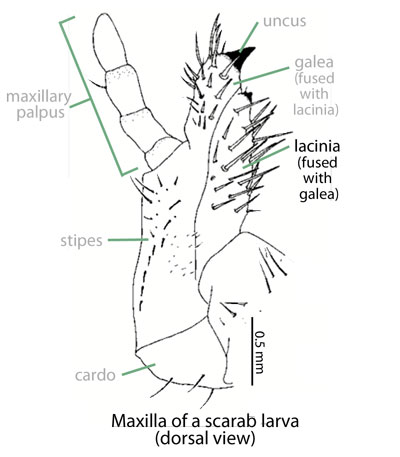Beneficial
grey dungball roller
Family: Scarabaeidae Subfamily: Scarabaeinae Genus: Neosisyphus Species: Neosisyphus spinipes (Thunberg, 1818)
none available
Total body length 7.5–12.0 mm (0.30–0.47 in). Body shape round, somewhat spherical. Color dark grey-brown. Clypeusclypeus:
part of the head anterior to the frons; the most anterior portion in dorsal view
 broadly emarginateemarginate:
broadly emarginateemarginate:
notched or with a rounded section removed from the margin, often applied to the anterior margin of the clypeus
. Pronotumpronotum:
the dorsal surface of the thorax
 with short, fine setaesetae:
with short, fine setaesetae:
small, hair-like structure
(may be missing in worn specimens). Hind and middle legs slender, greatly elongated. Hind trochantertrochanter:
a segment of the leg articulated with the femur and coxa
of male elongate, spine-like (lacking in female). AntennaeAntennae:
paired sensory organ on head, formed from numerous segments
 8-segmented. Pygidiumpygidium:
8-segmented. Pygidiumpygidium:
the last abdominal segment, usually exposed, not completely covered by the elytra
 with height greater than width.
with height greater than width.
Undescribed. For Scarabaeinae (Ritcher, 1966Ritcher, 1966:
Ritcher P. 1966. White grubs and their allies: a study of North American scarabaeoid larvae. Oregon State University Monographs, Studies in Entomology 4: 1-219.): Grub C-shaped, hump-backed, cylindrical, and cream-colored. Maxillamaxilla:
set of paired mouthparts located posterior to the mandibles
with galeagalea:
outer branch or lobe of the maxilla
 and lacinialacinia:
and lacinialacinia:
inner portion of the maxilla distinctly separate. AntennaeAntennae:
distinctly separate. AntennaeAntennae:
paired sensory organ on head, formed from numerous segments
 with 4 or 5 apparent segments. Distaldistal:
with 4 or 5 apparent segments. Distaldistal:
situated away from the point of articulation, thus usually furthest from the body
segment of antennaantenna:
paired sensory organ on head, formed from numerous segments
 much reduced in size. Epipharynxepipharynx:
much reduced in size. Epipharynxepipharynx:
lobe on the interior surface of the labrum or clypeus
with tormaetormae:
in scarab larvae, sclerotized structures on the ends of the clypeolateral suture extending towards the mesal line
united mesallymesally:
at or near midline of body
, anterioranterior:
the front or forward; opposite of posterior
phoba present. Legs 2-segmented. Anal opening surrounded by fleshy lobes.
Africa. This species is native to Africa, occurring from South Africa northward through East Africa to Ethiopia (Tyndale-Biscoe, 1990Tyndale-Biscoe, 1990:
Tyndale-Biscoe M. 1990. Common dung beetles in pastures of southeastern Australia. CSIRO Publishing, Clayton, Australia.). It was intentionally introduced to Australia (Bailey, 2007Bailey, 2007:
Bailey P. 2007. Pests of field crops and pastures: identification and control. CSIRO Publishing, Clayton, Australia. full text (accessed 2015)).
None. This species feeds on dung as both an adult and larvalarva:
the immature form of an insect; in scarabs, also called grub or white grub; preceded by the egg stage, followed by the pupal stage
 .
.
(Tyndale-Biscoe, 1990Tyndale-Biscoe, 1990:
Tyndale-Biscoe M. 1990. Common dung beetles in pastures of southeastern Australia. CSIRO Publishing, Clayton, Australia.): During the day, females search for fresh dung. Upon discovery, the female, with aid of the male, shapes a portion of the dung into a ball. Using the elongated hind legs, the pair rolls the dung ball from the original site before attaching it to the stem of nearby surface vegetation. A single egg is laid on the dung ball, with the egg taking 6–11 weeks to develop into an adult. Females rarely lay more than a single egg each day. In Australia, adults are most active between December and May, with several generations occurring each year (Bailey, 2007Bailey, 2007:
Bailey P. 2007. Pests of field crops and pastures: identification and control. CSIRO Publishing, Clayton, Australia. full text (accessed 2015)).
None. This species recycles dung and is beneficial for ranching and farming. As an obligate dung feeder, Neosisyphus spinipes poses no threat to crop or ornamental plants. Additionally, this species is not a threat to native dung beetles because none occur in Hawaii.
Recorded, not established. This species was intentionally released on Big Island in 1967 to help control populations of the horn fly (Haematobia irritans), a biting pest of livestock (Markin and Yoshioka, 1998Markin and Yoshioka, 1998:
Markin G and Yoshioka E. 1998. Biological control of the horn fly, Haematobia irritans L., in Hawai'i (Diptera: Muscidae). Proceedings of the Hawaiian Entomological Society 33: 43-50. full text (accessed 2015)). Despite this effort, Neosisyphus spinipes failed to establish on the island (Nishida, 2002Nishida, 2002:
Nishida G (editor). 2002. Hawaiian terrestrial arthropod checklist, fourth edition. Bishop Museum Technical Report 22: 1-313.).
Not established or recorded. There are no records of this species from Guam.
In Hawaii, this species was intentionally released but did not establish.
With its greatly elongate hind and middle legs, Neosisyphus spinipes is distinctive amongst dung beetles recorded from Hawaii. It is possible that this scarab might be confused with similar-shaped species of Canthon. N. spinipes is separated from the Canthon species by examining the legs (N. spinipes with middle and hind legs greatly elongated and with the hind trochantertrochanter:
a segment of the leg articulated with the femur and coxa
of the male long and spine-like versus Canthon dung beetles that possess less elongate legs and lack the elongated trochantertrochanter:
a segment of the leg articulated with the femur and coxa
) and antennaeantennae:
paired sensory organ on head, formed from numerous segments
 (N. spinipes with 8 segments versus Canthon species with 9 segments).
(N. spinipes with 8 segments versus Canthon species with 9 segments).
Sisyphus spinipes Thunberg
Report your observation of this beneficial species at our iNaturalist project.